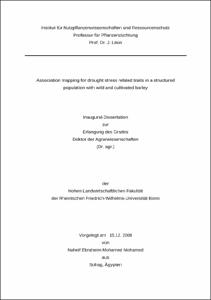Naheif, Ebraheim Mohamed Mohamed: Association mapping for drought stress related traits in a structured population with wild and cultivated barley. - Bonn, 2009. - Dissertation, Rheinische Friedrich-Wilhelms-Universität Bonn.
Online-Ausgabe in bonndoc: https://nbn-resolving.org/urn:nbn:de:hbz:5N-16699
Online-Ausgabe in bonndoc: https://nbn-resolving.org/urn:nbn:de:hbz:5N-16699
@phdthesis{handle:20.500.11811/3937,
urn: https://nbn-resolving.org/urn:nbn:de:hbz:5N-16699,
author = {{Ebraheim Mohamed Mohamed Naheif}},
title = {Association mapping for drought stress related traits in a structured population with wild and cultivated barley},
school = {Rheinische Friedrich-Wilhelms-Universität Bonn},
year = 2009,
month = feb,
note = {Association mapping is an alternative to mapping in a biparental population. A key to successful association mapping is to avoid superior associations by controlling the population structure and the kinship relations.
A structured population of 119 wild and cultivated barley genotypes (98 accessions of wild barley H. vulgare ssp. spontaneum from a core collection and 21 german spring barley cultivars) was used in this study. The experiments were carried out in plastic green house tunnels at Bonn University (Nord-Rhine-Westfalia, Germany) during the summer seasons 2007 and 2008. Pots were arranged in a split-plot design with non-replications; drip irrigation treatments were “well-watered” and “drought stress” with about half of the water amount in a period of 21 days starting 40 days after sowing. After that (before anthesis) plants were analysed and phenotypic data from in total 18 shoot, root and physiological traits were measured. The 119 accessions were genotyped by using 1081 DArT markers and the association analysis was performed with a mixed linear model (MLM) including Q and K matrix considering the population structure and the kinship relations.
The shoot traits wilting score (WS), shoot fresh weight (SFW), the root traits root length (RL), root fresh weight (total fresh weight RFW, FWa 0-10cm length, FWb 10-20cm length, FWc greater 20cm length) and root dry weight (RDW, DWc) and the the physiological traits relative water content (RWC) and proline content (PC) exhibited highly significant differences between the two irrigation treatments “well-watered” and “drought stress” in both seasons.
In the association analysis 79 markers were significantly correlated with the studied traits covering the whole genome of the structured Barley population. Different QTLs have been identified for different shoot, root and physiological traits. They are located all over the whole barley genome. These QTLs had main and / or interaction effects on improving or reducing the traits under well-watered and drought stress conditions.
Thirty co-locations of QTLs were found correlating with the studied traits covering the whole genome of the tested Barley population. Among these co-locations 18 regions were found to be associated with two traits, six co-locations with three traits and six co-locations were affected by more than three traits.
The most important co-locations which have been obtained in the current study were bpb- 3574 on chromosome 2H (49.03 cM) associated with RL and RWC, bpb-2910 on chromosome 3H (51.59 cM) associated with RWC and total shoot dry weight (SDW) and bpb-1408 on chromosome 4H (60.04 cM) associated with WS, RL, FWc, RWC and PC.},
url = {https://hdl.handle.net/20.500.11811/3937}
}
urn: https://nbn-resolving.org/urn:nbn:de:hbz:5N-16699,
author = {{Ebraheim Mohamed Mohamed Naheif}},
title = {Association mapping for drought stress related traits in a structured population with wild and cultivated barley},
school = {Rheinische Friedrich-Wilhelms-Universität Bonn},
year = 2009,
month = feb,
note = {Association mapping is an alternative to mapping in a biparental population. A key to successful association mapping is to avoid superior associations by controlling the population structure and the kinship relations.
A structured population of 119 wild and cultivated barley genotypes (98 accessions of wild barley H. vulgare ssp. spontaneum from a core collection and 21 german spring barley cultivars) was used in this study. The experiments were carried out in plastic green house tunnels at Bonn University (Nord-Rhine-Westfalia, Germany) during the summer seasons 2007 and 2008. Pots were arranged in a split-plot design with non-replications; drip irrigation treatments were “well-watered” and “drought stress” with about half of the water amount in a period of 21 days starting 40 days after sowing. After that (before anthesis) plants were analysed and phenotypic data from in total 18 shoot, root and physiological traits were measured. The 119 accessions were genotyped by using 1081 DArT markers and the association analysis was performed with a mixed linear model (MLM) including Q and K matrix considering the population structure and the kinship relations.
The shoot traits wilting score (WS), shoot fresh weight (SFW), the root traits root length (RL), root fresh weight (total fresh weight RFW, FWa 0-10cm length, FWb 10-20cm length, FWc greater 20cm length) and root dry weight (RDW, DWc) and the the physiological traits relative water content (RWC) and proline content (PC) exhibited highly significant differences between the two irrigation treatments “well-watered” and “drought stress” in both seasons.
In the association analysis 79 markers were significantly correlated with the studied traits covering the whole genome of the structured Barley population. Different QTLs have been identified for different shoot, root and physiological traits. They are located all over the whole barley genome. These QTLs had main and / or interaction effects on improving or reducing the traits under well-watered and drought stress conditions.
Thirty co-locations of QTLs were found correlating with the studied traits covering the whole genome of the tested Barley population. Among these co-locations 18 regions were found to be associated with two traits, six co-locations with three traits and six co-locations were affected by more than three traits.
The most important co-locations which have been obtained in the current study were bpb- 3574 on chromosome 2H (49.03 cM) associated with RL and RWC, bpb-2910 on chromosome 3H (51.59 cM) associated with RWC and total shoot dry weight (SDW) and bpb-1408 on chromosome 4H (60.04 cM) associated with WS, RL, FWc, RWC and PC.},
url = {https://hdl.handle.net/20.500.11811/3937}
}






